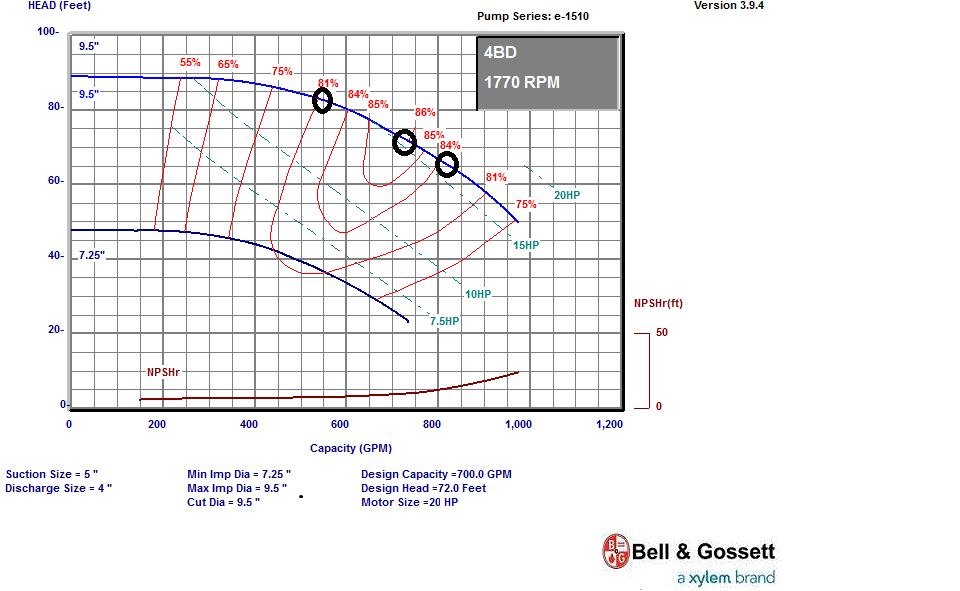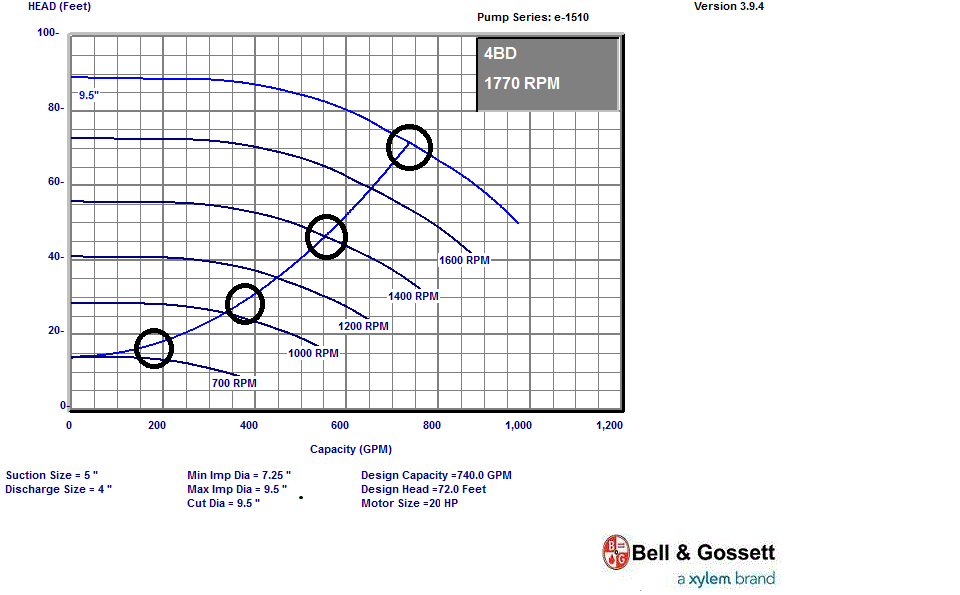Under the DOE’s new efficiency standards for pumps, all Pump Efficiency Rating (PER) values use a full size or maximum impeller for a given pump and start at the pump’s best efficiency point (BEP). As you may recall from our last Monday Morning Minutes post, the new efficiency standard includes two versions of the PER, one for constant load operation (PERCL) and one for variable load operation (PERVL).
Calculating PERCL Values
Let’s look at calculating PER values for pumps nameplated with the PERCL. The PERCL uses an equal percentage rating of measured or calculated input horsepower (IHP) at 100%, 110%, and 75% of BEP. Thus,
PERCL ≈ (IHP100% BEP + IHP110% BEP + IHP75% BEP)/3.
For example, a Bell & Gossett e1510-4BD has its best efficiency point (100%) at about 740 GPM and 86% efficiency. At 110% of BEP, the flow is about 814 GPM and at 75% of BEP, the flow is about 550 GPM. The horsepower would be measured or calculated at these three points and each horsepower would be weighted equally by multiplying each by 0.3333 (dividing by 3).
Calculating PERVL Values
Just like PERCL efficiency ratings, PERVL efficiency ratings are based on a full size or maximum impeller for a given pump, and start at BEP. The PERVL also uses a control curve since it is based on variable-speed operation. The control curve uses a control head or head at “0” GPM of 20% of BEP at full speed. Following this control curve, the input horsepower is determined at 100%, 75%, 50%, and 25% of BEP.
Let’s look at an example.
The following curve for the same e1510-4BD shows points on the intersection of the control curve and the variable speed pump curve at 100% or 740 GPM, 75% or 555 GPM, 50% or 370 GPM, and 25% or 185 GPM. The input power is equally weighted at all four points.
Thus,
PERVL ≈ (IHP100% BEP + IHP75% BEP + IHP50% BEP + IHP25% BEP /4.
Be Careful When Comparing Pump Efficiency Indexes!
Pump manufacturers will have the option to rate their pumps based on constant speed, variable, or both. Here’s where it gets confusing. Notice that that the pump input power under constant speed and the pump input power under variable speed are both divided by the same number. This could be misleading if a pump is chosen based on its PERVL rating.
Obviously, the horsepower used by a pump with a properly applied VFD will be less than a pump without a drive. Since PEIVL takes into account energy savings with a VFD, it will always lead to a lower value than the constant speed rating. That doesn’t mean the pump is comparably efficient to other pumps in a constant or variable speed application. In fact, a pump with a PEIVL may not even make the DOE’s cut as constant speed pump, but because it meets the efficiency standard when used with a VFD, the manufacturer can continue to make it.
For that reason, we recommend only looking at pumps that have achieved the higher certification – PEICL. If you’re going to include any reference to PEI in your specification, we recommend you use the following: Pumps supplied shall meet and be nameplated with the PEICL requirements of the U.S. Department of Energy (DOE) Energy Conservation Standards for Pumps.
Additionally, if a manufacturer says a pump meets the VL standard, it must supply the VFD with the pump. Thus, the owner cannot choose any other brand of VFD; it must be the VFD and controls with which the pump has been rated.
So the best way to guarantee optimum efficiency is to only choose CL-rated pumps, regardless of whether the pump is to be used in a variable or constant speed application.
But is this the best way to measure a pumps true efficiency when being applied into an HVAC system? Stay tuned for our next article for a better way to measure pump efficiency by taking into account real part load operation.



